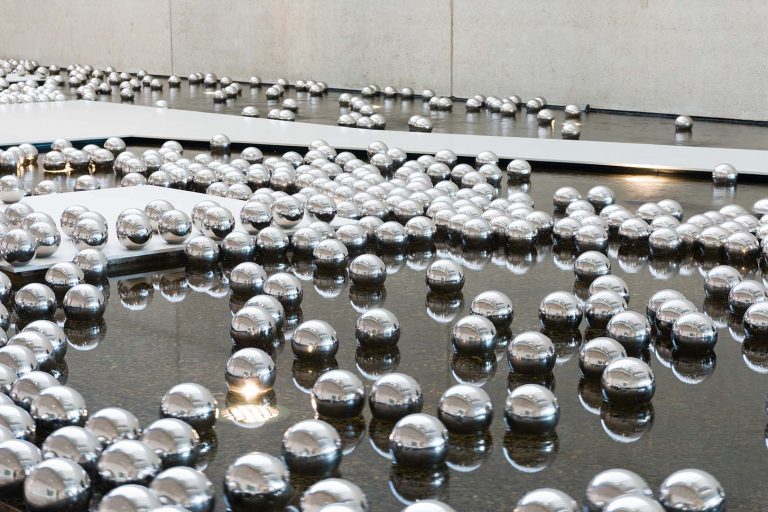We acknowledge the Traditional Owners of the land on which the Queensland Art Gallery | Gallery of Modern Art stands and recognise the creative contribution First Australians make to the art and culture of this country.

Yayoi Kusama / Japan b.1929 / Narcissus garden (installation view) 1966/2002 / Stainless steel balls / 2000 balls (approx.): 17cm (diam., each); installed size variable / Gift of the artist through the Queensland Art Gallery Foundation / Collection: Queensland Art Gallery | Gallery of Modern Art / © Yayoi Kusama
Yayoi KusamaNarcissus garden 1966–2002
Not Currently on Display
Furthering Yayoi Kusama’s reflective mode are various incarnations of her Narcissus garden, an environmental work that has held the artist’s attention for over forty years. Here Kusama creates a carpet of mirrored spheres. The mirror balls reflect one other, creating an infinitely recurring web in which the surrounding visible world is trapped and perpetuated.
Narcissus garden first appeared at the Venice Biennale in 1966 when Kusama, although uninvited, installed 1500 plastic reflective balls on the grass outside the Italian Pavilion. Dressed in a gold kimono, the artist distributed printed accolades of her work by Herbert Read and attempted to sell her reflective multiples at 1200 lire each. This caused huge consternation amongst the authorities, who were offended by this act of blatant commercialism. In stark contrast, nearly thirty years later in 1993, Kusama was the first individual artist and only woman to officially represent Japan in its pavilion at Venice.
Narcissus garden was conceived especially for APT 2002 for installation in the Gallery’s Watermall; however this work may be installed in multiple configurations in interior and outdoor locations. The spectacular work represents a culmination of this important artist’s fervent artistic practice that spans more than four decades.
Yayoi Kusama is one of the most significant artists to emerge from Asia in the postwar period. Kusama was born in Matsumoto, Nagano prefecture, Japan in 1929 and was the youngest of four children. By 1941, as a twelve-year-old child, she had begun to notate and paint hallucinations, which she experienced as veils of dots.
During the early 1950s, Kusama recognised that the visual and aural hallucinations she had experienced for a decade were symptomatic of a condition known as ‘rijin’sho’ (depersonalisation syndrome). Kusama continues to experience these hallucinations to this day.
As an adult Kusama developed a vibrant visual iconography composed of dots, often transposed as nets or auras, that has become the familiar visual vocabulary dominating her artistic practice. Kusama moved to New York in 1955, where she lived and worked until 1972, before returning to Japan. Kusama’s practice embraces drawing, painting, collage, sculpture, performance, fashion, tabloid publishing, filmmaking, installation, novels, poetry and music.